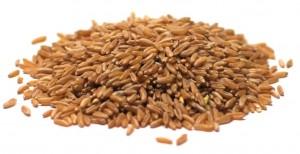
Description
Kamut, a forefather of modern wheat, is that rare food item that tastes yummy, offers abundant health benefits and has an entertaining backstory. Grown in ancient Egypt, the Middle East and Southwest Asia, this grain dropped off the international radar with the advent of modern wheat farming. Its resurrection began when a US airman, stationed in Portugal after WWII, stumbled across some kamut berries, allegedly retrieved from ancient Egyptian pyramids. He airmailed the kernels home to his father, a wheat farmer, who successfully grew them and subsequently displayed his “King Tut’s Wheat” at a county fair. Four decades later, one enterprising farmer—who had attended that fair as a child—started marketing kamut on a commercial basis. This specialty crop now covers about 16,000 acres in Montana, Saskatchewan and Alberta.
Kamut’s taste is sufficient reason for the resurgent interest: buttery, nutty, slightly sweet. Ground into flour, kamut substitutes well for modern wheat in diverse baked goods, resulting in a denser, but also finer consistency. Twice as large as wheat kernels, golden kamut berries have a pleasingly chewy texture when slow-cooked and eaten as a breakfast cereal, salad filler, snack or side dish.
When it comes to health benefits, kamut wins hands down over modern wheat. It contains 30 percent more protein and substantially more zinc, manganese, phosphorus and Vitamin E. Several small medical studies conducted in the past 15 years suggest that kamut can lower bad cholesterol and balance blood sugar levels for the diabetic. Another health plus is kamut’s unmodified status, growing hardily without pesticides. Because it contains less gluten than modern wheat, people sensitive to wheat may be able to handle kamut without digestive distress.
Pickup
Not available
Seller does not offer local pickup
Delivery
Not available
Seller does not offer delivery
Ships
Not available
Seller does not offer shipping
Keywords
Resale Other